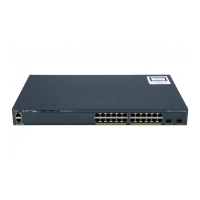CHAPTER
39-1
Catalyst 2960 and 2960-S Switches Software Configuration Guide, Release 15.0(1)SE
OL-26520-01
39
Troubleshooting
This chapter describes how to identify and resolve software problems related to the Cisco IOS software
on the Catalyst 2960, 2960-S, or 2960-C. Depending on the nature of the problem, you can use the
command-line interface (CLI), the device manager, or Network Assistant to identify and solve problems.
Unless otherwise noted, the term switch refers to a standalone switch and to a switch stack.
Note Stacking is supported only on Catalyst 2960-S switches running the LAN base image.
Additional troubleshooting information, such as LED descriptions, is provided in the hardware
installation guide.
Note For complete syntax and usage information for the commands used in this chapter, see the command
reference for this release and the Cisco IOS Commands Master List, Release 12.4 on Cisco.com.
This chapter consists of these sections:
• Recovering from a Software Failure, page 39-2
• Recovering from a Lost or Forgotten Password, page 39-3
• Preventing Switch Stack Problems, page 39-8
• Recovering from a Command Switch Failure, page 39-8
• Recovering from Lost Cluster Member Connectivity, page 39-12
Note Recovery procedures require that you have physical access to the switch.
• Preventing Autonegotiation Mismatches, page 39-12
• Troubleshooting Power over Ethernet Switch Ports, page 39-13
• SFP Module Security and Identification, page 39-13
• Monitoring SFP Module Status, page 39-14
• Using Ping, page 39-14
• Using Layer 2 Traceroute, page 39-15
• Using IP Traceroute, page 39-17
• Using TDR, page 39-19
• Using Debug Commands, page 39-19

